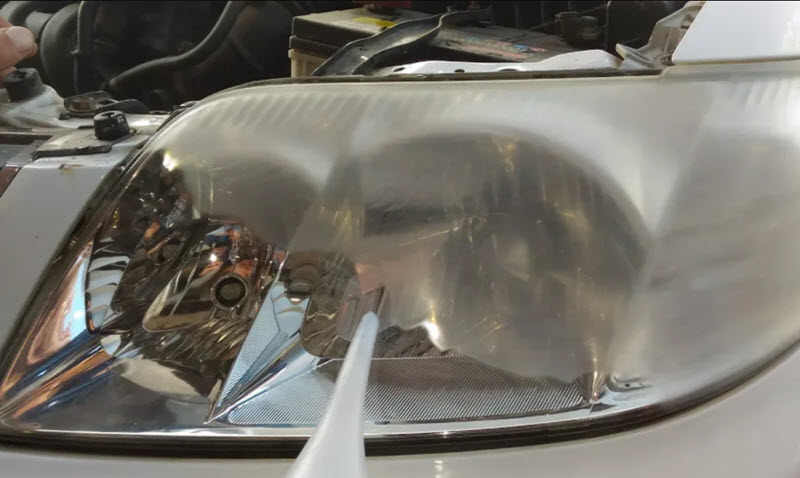
Polishing plastic and glass headlights - proven methods
Content
Car headlights are covered from the outside with transparent caps, which once served as deflectors of the light flux. Now they provide only a decorative and protective function for the complex optics located inside the headlight. It is important that they always remain transparent and do not spoil the appearance of the car, hence the need for mechanical processing that sometimes arises.
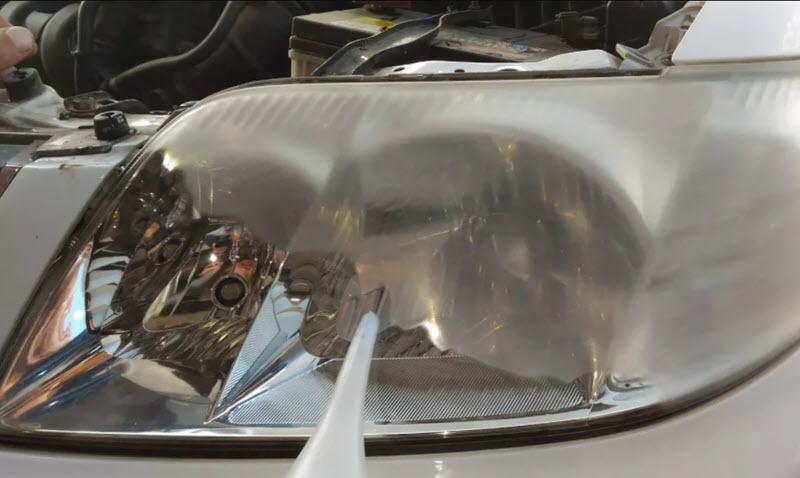
Why do car headlights dim?
The location of the headlights on the body is such that they take on everything that gets into the polluted air, blowing the car at high speed.
The cap is exposed to several aggressive factors at once:
- abrasive dust raised by vehicles in front and oncoming vehicles;
- numerous aggressive chemicals in the composition of road dirt;
- the ultraviolet component of sunlight;
- internal light in the same range emitted by the headlight, it is weaker than sunlight, but is not limited to the completely visible part of the spectrum;
- high temperature of the radiating element, halogen incandescent lamps, xenon or LED sources.
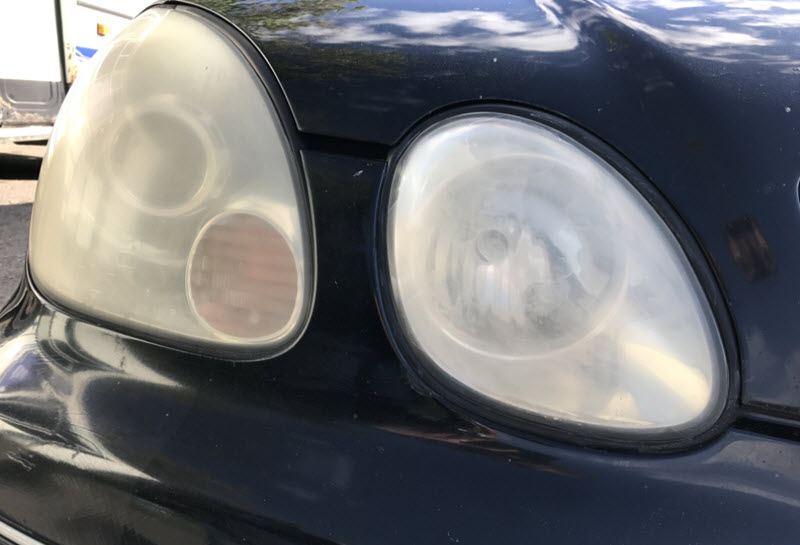
In addition, the outer surface of the headlights suffers during washing, there is always a certain amount of abrasive substances in the water.
And some drivers stubbornly finish off the lighting fixtures, like the entire body, having the habit of simply wiping the dirt with a rag or sponge with a minimum or complete absence of water.
What is polishing for?
Over time, for all the above reasons, the outer side of the cap is covered with a network of microcracks. They are not visible to the naked eye, but the picture of general turbidity is perfectly visible. In addition, the chemical composition of the surface layer changes.
Transparency can only be restored mechanically, that is, by removing the damaged thinnest film from cracks and substances that do not transmit light well using fine grinding and polishing.

Tools and materials
With any polishing, headlights are no exception, the following consumables, fixtures and equipment can be used:
- polishing pastes of varying degrees of hardness and graininess;
- sandpaper by numbers, from fairly coarse (in terms of polishing, not rubbing holes) to the finest;
- polishing machine with electric drive;
- nozzles to it, or to a drill in its absence;
- sponges for manual and mechanical work;
- masking tape for gluing adjacent sections of the body;
- washing solution based on car shampoo with a good surface-active effect.
Theoretically, you can polish manually, but the process takes too much time. Therefore, a regular variable speed polisher or similar electric drill will be a good compromise between manual polishing and a professional orbital polisher.
Polishing plastic headlights
Almost all available headlights have long been equipped with an external cap made of polycarbonate. Glass deflectors are few and far between.
A feature of such lighting devices is the low hardness of even the best of these plastics. Therefore, a thin ceramic layer is usually applied to them, which has the hardness, if not of glass, then at least provides an acceptable service life.
This must be remembered when polishing and proceed carefully, otherwise you will have to renew this protection. Which is no longer so easy and cheap.
With toothpaste
The simplest polish is toothpaste. By the nature of its activity, it must contain dental abrasives.
The problem is that all pastes are different, and the amount, as well as the grit and hardness of the abrasive in them, can vary from zero to unacceptably high.
For example, whitening pastes can work like coarse sandpaper when applied to plastic headlights, and even by machine. Therefore, it is necessary to work with the paste carefully and after preliminary tests, otherwise the headlight will be ruined.
The process itself is quite simple, the paste is applied to the surface and polished manually with a rag or sponge.
Gel pastes are not suitable, there is no abrasive in them at all, these are purely detergent compositions. Chalk-based or sodium bicarbonate pastes are also of little use. Only those that contain silicon dioxide based abrasive are suitable.
With sandpaper
Sandpaper is used for primary processing of heavily damaged surfaces. It removes relatively large scratches.
The surface after processing becomes even more matte than it was. Gradually increasing the number (you can start from 1000 or 1500), they achieve an increase in the transparency and gloss of the surface, but then it still needs to be polished.
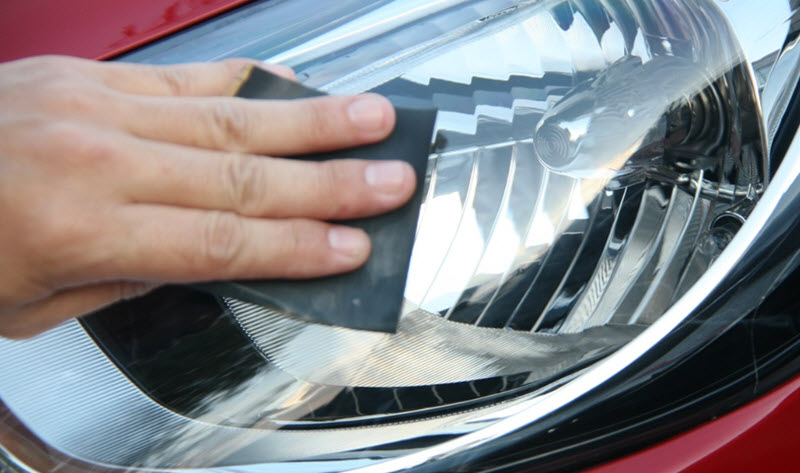

Work should be done manually, the paper is fixed on a special soft holder. You can’t just hold it with your fingers, the processing will be uneven due to different pressure on sections of the paper.
Grinding is done with an abundance of water, dry friction is unacceptable. As well as strong pressure on the grinding device.
With abrasive polish and sponge
All abrasive polishes are also subdivided according to the degree of grit. The most rough ones are used in manual processing, mechanization immediately “digs up holes”, which cannot be eliminated later.
Actually, the polish is the same polishing paste, only already diluted and ready for use. They are applied in a thin layer to the headlight and polished with a suitable foam pad for the machine.
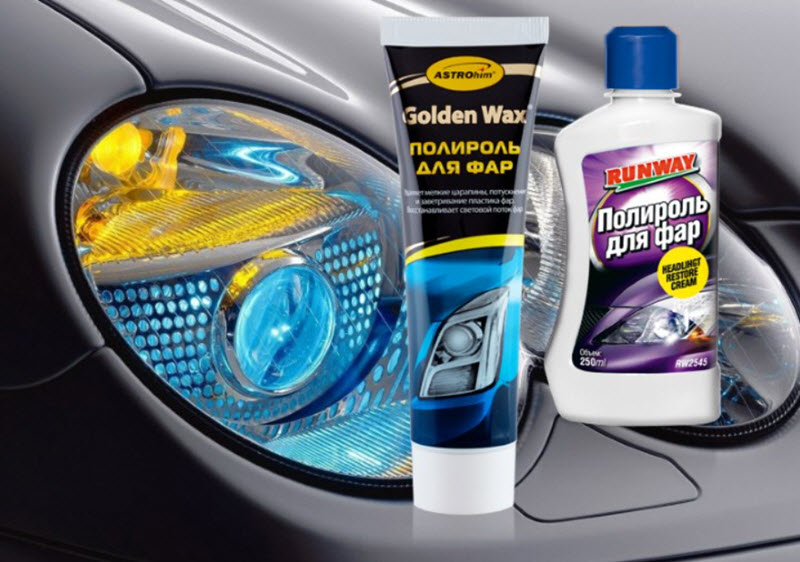

With polishing paste and grinder
A good polishing paste is already prepared to the desired consistency and is designed to work with a foam pad of a certain hardness. The softest discs work with the finest pastes in finishing operations.
The paste is applied to the headlight. If you put it on a disk, then there will not be much difference, except for large losses, it will fly apart under the action of centrifugal forces. It is necessary to work at low speeds, not higher than 500 per minute. So the surface wears out less, and the risk of overheating is reduced.
For plastics, this is dangerous, at high temperatures they become cloudy and turn yellow. The rotating disk must be continuously moved in a circular motion.
Periodically, the layer is updated with the control of the result. Cutting off a lot of material is not worth it, the headlight can only withstand 2-3 polishes, after which it is necessary to renew the ceramic lacquer coating.
How to polish glass headlights
The only difference is the hardness of the cap material. Glass can only be processed with GOI pastes or similar, diamond or other types, intended for classical optics.
Sandpaper is not used, as is the manual method. The speed of the polisher can be higher than in the case of plastic. There are also special restoring polishes for glasses. They fill the cracks with polymer, and then polish.


Watch this video on YouTube
Features of internal polishing
Internal polishing is not fundamentally different from external polishing, but it is more difficult due to the reverse curvature of the surface. But it is rarely required.
To carry it out, the headlight will have to be removed and disassembled. Usually the glass is fixed on a special sealant, which will have to be purchased. The headlight must be sealed, otherwise it will constantly fog up.


Watch this video on YouTube
Headlight protection methods
If the ceramic lacquer layer has already been erased from the surface, then it should be restored. An alternative to it can be glass coating with a special protective armoring film, varnish of various compositions or according to factory ceramic technology. The latter is difficult to do at home.
Lacquer is also not easy to apply evenly, but it does not last long. Therefore, the best way out is to use a film that is cheap, but sticks after some training quickly and requires only pre-washing and degreasing.
Before sticking, the film should be slightly warmed up with a hair dryer, after which it will exactly repeat the surface of the headlight of any shape.
